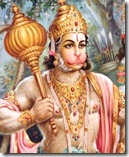 “Perseverance is the root of good fortune. Perseverance leads to supreme happiness. Therefore I will search again, in those areas where I have not searched already.” (Hanuman, Valmiki Ramayana, Sundara Kand, 12.10)
“Perseverance is the root of good fortune. Perseverance leads to supreme happiness. Therefore I will search again, in those areas where I have not searched already.” (Hanuman, Valmiki Ramayana, Sundara Kand, 12.10)anirvedaḥ śriyo mūlam anirvedaḥ param sukham |
bhūyas tāvad viceṣyāmi na yatra vicayaḥ kṛtaḥ ||
? Though known for his supreme prowess, his ability to ward off the staunchest enemies, his knack for changing his shape to match the situation, and his undying devotion to
Lord Rama
, the Supreme Personality of Godhead, Hanuman’s level of affection and concern for his dear friends is also impossible to measure. He never wants anything for himself, though he is deserving of the whole world. He is praised and honored daily by millions, but he only takes that as a sign of the greatness of the person he serves and thinks about every day. Whatever mood we find ourselves in, if we simply remember Hanuman, the quality of his heart and who resides there eternally, how can dejection and sadness stay for long? Shri Rama’s messenger searches through thick and thin, the darkness and the light, and among friend and foe alike to shine the torchlight of devotion, the divine vision of his smiling and soothing face, onto those who are deserving of it.
In the above referenced verse from the Ramayana, Hanuman is turning around his depressing thoughts and channeling them towards excitement, anticipation and confidence in battle. His mission was simple: find the missing princess of Videha, Lord Rama’s wife. Since these events transpired during the Treta Yuga, the second time period of creation, even the monkey species roaming the earth was advanced to some degree. They befriended the jewel of the Raghu dynasty, who was roaming the forests at the time due to family troubles at home. When Rama’s wife went missing, the Lord and His younger brother befriended the monkey-king Sugriva residing in Kishkindha. The meeting took place because of Hanuman, who is the best messenger anyone could ask for.
“O sinless one, certainly how can any king accomplish his objectives if he doesn't have such a messenger working for him?” (Lord Rama speaking to Lakshmana about Hanuman,
Valmiki Ramayana
, Kishkindha Kand, 3.34)
upon first meeting Hanuman that no king could ever get his business accomplished without having a messenger like Hanuman. As Rama is Himself a king - the king of the universe - for tending to business He also uses Hanuman. Therefore no one was a better candidate for finding Sita and returning the information of her whereabouts. As a parent if you give an important task to your child, they will usually be enthusiastic to work. The adult has responsibilities and other things they would rather be doing, but the child looks for any opportunity to take on something important, to act like a grown up.
Though Hanuman was in an adult monkey body, he nevertheless took on the mission with the enthusiasm of the most sincere child. His love for Rama was pure, and that’s all he needed for success. Yet even with his excitement and fervent desire to succeed, there were troubles encountered. Upon reaching the enemy territory of Lanka, where it was heard that Sita had been taken, Hanuman searched and searched. He went through apartment after apartment, room after room, but Sita he could not find. He discovered seemingly everything else in Lanka, including the beautiful women married to the king Ravana, the leader of the Rakshasa clan.
Rakshasas are human-like creatures given to sinful activity, with the most notable repugnant behavior being their eating of human flesh. Indulgence in wine and women rounds out the picture, so we can just imagine what kind of place Hanuman entered. Hanuman is fixed in righteousness, or siddha. He has no blemishes in his character, and yet he found himself in “sin city” forced to look at things he didn’t want to see. He was able to properly justify to himself the gazing upon women who were wives of another man, but his resolve started to crack as more time went by without finding Sita.

In the situation of the above referenced verse, Hanuman is thinking that Sita must have perished, that she couldn’t be in Lanka. “I’ve looked everywhere in this place. There isn’t one inch of space that I haven’t uncovered. She must not be here. I couldn’t blame her either, as she probably quit her body upon looking at the ghoulish creatures that live here and their horrible behavior. She is the embodiment of chastity and virtue, so how could she possibly survive for long without Rama by her side?”
Hanuman’s premonition was well founded, but now he had to figure out what that predicament would cause. If Sita was in fact not in Lanka, if Ravana had maybe killed her, what would Hanuman say when he returned to the monkey camp? This is where his true kindness and undying love for Rama and the Lord’s friends was again exhibited. Hanuman thought of what everyone would say, how Sugriva would become angry that the mission he assigned to the monkeys on behalf of Rama was not complete. Hanuman thought of his monkey friends, with whom he had persevered through a long search, who had given him the encouragement to leap over the massive ocean that separated Lanka from the mainland. After what they had been through, how could Hanuman return as a failure? He couldn’t bear to face his friends and see the dejection on their faces. He was fine with having failed himself, for Hanuman is never concerned over his stature or fame. But he never does anything that will cause harm to his friends.
Past military leaders and war heroes have uttered phrases which are today famous declarations of dedication and resolve. “Give me liberty or give me death” and “I have not yet begun to fight” embody the chivalrous spirit of the dedicated warrior. Yet long before these phrases were uttered, many thousands of years ago, before the modern incarnation of organized military conflict, Hanuman reminded himself of the importance of perseverance, giving himself a small pep talk in the process. Hanuman rightly concluded that perseverance is the source of good fortune, that it brings supreme happiness.
The opposite of perseverance is weakness in resolve, giving up rather quickly. It is much easier to give up when there is no enthusiasm in the task to begin with, when the reward is not worth the effort. For Hanuman such issues were not present. He took the task assigned to him by Rama as his life and soul, and he knew that finding Sita would be the greatest reward anyone could ask for. Therefore he rightly concluded that perseverance in this case would lead to good fortune.
Sita Devi
resides eternally in the spiritual sky as the goddess of fortune, so anyone who is fortunate enough to please her by dedicating their life to serving her husband, God, will always be in her good graces.
Perseverance also brings supreme happiness. If we don’t put in our best effort and fail in a task, there will be so much regret later on. “I really wish I would have tried harder. I wish I had given it my all. Maybe then the outcome could have been different.” In many instances, even if there isn’t ultimate victory, if the perseverance is still there then there is every reason to be proud. Hanuman would find supreme happiness by remaining dedicated in his service to Rama. He would eventually find Sita, and all would end well.

Who among us hasn’t tasted defeat? Who among us hasn’t searched for something or someone repeatedly, only to have failed? The genesis of the material creation is the flawed search for happiness in the absence of God’s association. The search can go on and on, even in planets outside of earth, for that elusive happiness, but it will never be found. The only path towards lasting happiness is spiritual life, and more specifically the discipline of bhakti-yoga, or
devotional service
.
the holy names of the Lord, “
Hare Krishna Hare Krishna, Krishna Krishna, Hare Hare, Hare Rama Hare Rama, Rama Rama, Hare Hare
”, is the most auspicious activity because it keeps the mind engaged in Truth, the consciousness focused on an area where God eternally resides. Though the Lord is everything, He is not personally present within every sphere. Rather, He lives in the hearts of those who regularly chant His names and delight in descriptions of His pastimes and glories. Those who reproduce the sound vibrations of Krishna and Rama, two wonderful names describing the Supreme Lord’s transcendental body and limitless attributes of opulence, find the Lord with them at all times.
In the path of bhakti-yoga, which leads to emancipation, there may arise difficulties. “I’ve been chanting for so long and I don’t feel anything. I’ve looked here and there and still I don’t realize God.” But as Hanuman says, perseverance leads to good fortune, to supreme happiness. If after chanting so much and abstaining from the four pillars of
sinful life
[meat eating,
gambling
,
intoxication
and
illicit sex
], we still don’t feel that God is with us, the solution is not to abandon our dedication and return to association with
maya, or material nature. Maya has already been searched thoroughly to no avail in both this lifetime and many previous ones as well.
Faced with the possibility of failure, Hanuman decided to renew his search, to go places where he had not gone before. When we have momentary lapses of judgment and feelings of dejection in our devotional efforts, the key is to delve even deeper into spiritual life, to uncover those practices that we have yet to take up. We can chant more rounds, read more books, visit more temples, or simply hear more about the Lord from people who love him, who follow in Hanuman’s footsteps by dedicating their life and soul to pleasing the Supreme Lord. Just as Hanuman was eventually successful, the weary soldier trying to win the war against the material nature that inhibits his spiritual growth too will ultimately prevail.
Who can be more concerned over the welfare of their friends and family than Hanuman? The answer is “no one”. Therefore anyone who has a sincere desire to connect with God through bhakti will surely catch Hanuman’s eye. He will be concerned about their welfare to the same level as if they were a family member. This shows one of the many reasons why Hanuman is so passionately worshiped, honored, adored, and remembered by followers of the Vedic tradition. Hanuman casts a shadow that is impossible to break out of for those following the path of divine love. By using that shadow for comfort, as relief from the intense heat of material existence, the chances for success in life’s mission increase all the more.

Who can better deal with the distresses that come with temporary failure than Hanuman? After all he had been through, it would have been understandable if he would have quit, thrown in the towel, and decided to return home. Yet that wasn’t an option for him. He’d rather fight every single Rakshasa in Lanka and punish them for whatever they had done to Sita than return home without news of the whereabouts of the princess. His supreme wisdom borne of his devotion to Rama kept him going, giving him the fortitude necessary to remain calm in the face of major duress.
Seeing Hanuman’s thoughts and level of dedication, we can’t help but be touched by them. Since the events of the Ramayana took place so long ago and describe attributes and creatures not seen on the earth today, it is very easy to discount the whole poem as being mythology. Yet the wonderful dedication of Hanuman and his very character alone prove that Rama can be none other than the Supreme Lord, whom the entire creation is given to worship and honor. Where Shri Rama finds people like Hanuman to serve Him is a mystery. Even Lord Brahma, the creator, is enamored by Hanuman’s exhibition of divine love, for who could ever imagine a creature like him roaming the earth? The mystery of Hanuman’s character and immeasurable devotion is known only to the Lord, who always has the best friends and well-wishers. Should we one day be fortunate enough to consider ourselves among that illustrious group of souls, our existence will have proved fruitful.
In Closing:
To keep firm resolve under duress,
Is what can lead to success.
To the task at hand keep focus in,
Perseverance leads to good fortune.
These postulates Hanuman himself did remind,
So that he wouldn’t fail in Sita to find.
Because his character is kind and sweet,
Victory he'd ultimately meet.
He gives the lesson for us to follow,
In sadness and failure don't wallow.
Have perseverance in your bhakti practice,
To always remember Hanuman your mind insist.
 “Perseverance is the root of good fortune. Perseverance leads to supreme happiness. Therefore I will search again, in those areas where I have not searched already.” (Hanuman, Valmiki Ramayana, Sundara Kand, 12.10)
“Perseverance is the root of good fortune. Perseverance leads to supreme happiness. Therefore I will search again, in those areas where I have not searched already.” (Hanuman, Valmiki Ramayana, Sundara Kand, 12.10) Shri Rama correctly noted to
Shri Rama correctly noted to  In the situation of the above referenced verse, Hanuman is thinking that Sita must have perished, that she couldn’t be in Lanka. “I’ve looked everywhere in this place. There isn’t one inch of space that I haven’t uncovered. She must not be here. I couldn’t blame her either, as she probably quit her body upon looking at the ghoulish creatures that live here and their horrible behavior. She is the embodiment of chastity and virtue, so how could she possibly survive for long without Rama by her side?”
In the situation of the above referenced verse, Hanuman is thinking that Sita must have perished, that she couldn’t be in Lanka. “I’ve looked everywhere in this place. There isn’t one inch of space that I haven’t uncovered. She must not be here. I couldn’t blame her either, as she probably quit her body upon looking at the ghoulish creatures that live here and their horrible behavior. She is the embodiment of chastity and virtue, so how could she possibly survive for long without Rama by her side?” Who among us hasn’t tasted defeat? Who among us hasn’t searched for something or someone repeatedly, only to have failed? The genesis of the material creation is the flawed search for happiness in the absence of God’s association. The search can go on and on, even in planets outside of earth, for that elusive happiness, but it will never be found. The only path towards lasting happiness is spiritual life, and more specifically the discipline of bhakti-yoga, or
Who among us hasn’t tasted defeat? Who among us hasn’t searched for something or someone repeatedly, only to have failed? The genesis of the material creation is the flawed search for happiness in the absence of God’s association. The search can go on and on, even in planets outside of earth, for that elusive happiness, but it will never be found. The only path towards lasting happiness is spiritual life, and more specifically the discipline of bhakti-yoga, or  Who can better deal with the distresses that come with temporary failure than Hanuman? After all he had been through, it would have been understandable if he would have quit, thrown in the towel, and decided to return home. Yet that wasn’t an option for him. He’d rather fight every single Rakshasa in Lanka and punish them for whatever they had done to Sita than return home without news of the whereabouts of the princess. His supreme wisdom borne of his devotion to Rama kept him going, giving him the fortitude necessary to remain calm in the face of major duress.
Who can better deal with the distresses that come with temporary failure than Hanuman? After all he had been through, it would have been understandable if he would have quit, thrown in the towel, and decided to return home. Yet that wasn’t an option for him. He’d rather fight every single Rakshasa in Lanka and punish them for whatever they had done to Sita than return home without news of the whereabouts of the princess. His supreme wisdom borne of his devotion to Rama kept him going, giving him the fortitude necessary to remain calm in the face of major duress.